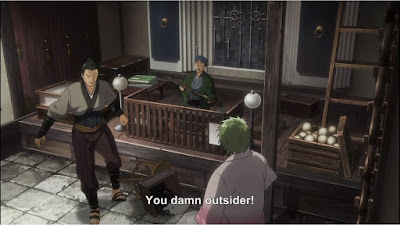I was hoping for something big again this week. Big shame, it didn't happen. Perhaps it needed a cooldown from the last encounter with the huge Shadow. This episode seven of Kabaneri of the Iron Fortress, Begging the Heavens, did open up some new facts about Mumei--who seems to be getting all the attention nowadays. Spoilers ahead.
IF there are heavy spoilers here. For the first part, largely there were just some separate stories.
Quite interesting to see them involved in a rather relaxed training session (compared to the one with Mumei all those episodes ago). Nothing much to comment here.
And finally, they arrived at somewhere not overran by kabane. The story will get repetitive otherwise. One other thing that did broke the repetition was him being slapped with a sword by Kurusu.
The moment they arrived at the station, when they all decided that they will celebrate a festival, we should know that this was going to be a relaxed, perhaps filler episode.
What are these scenes doing here? Yes, they show their humanity, but like in Grimgar, excessive use of these scenes just remove us from all the action.
At the very least, there were still something going on when Ikoma and Takumi were looking for supplies. Teaching a thing about behaving to a soldier was, sadly, painfully relatable. However, as a kabaneri, Ikoma did have no big deal on facing him.
At least, they managed to stuff in a little irony that he used Kurusu's move at the beginning.
Perhaps this next scene was only for the sake for a tie-in to the first train accident at the beginning. This was, at the very least, a moving moment, when Sukari told the kid that his father was dead, telling him that basically he needs to face his problems and live. Perhaps that was the whole theme of the show.
And what do we have here. Kurusu actually blushing after overlooking Ayame snacking. Seriously, this was, while does indeed deserve a laugh, still just a mere filler.
Afterward, they struck a deal with the lord of the station, who seem to be too willing to give them hospitality.
Meanwhile, the old man that was with Mumei two episodes ago seemed to be some kind of a scout for some group called the Hunters, who shall be approaching soon.
Now, both of these led to me wanting some kind of a political tension or maneuvering, at least something complicated with the higher-ups. However, due to Kabaneri's theme, I am more inclined to believe that they won't be stepping into that realm.
The same sunset, it seems Mumei has retreated to a shrine, to where Ikoma followed her.
Apparently, Mumei was suddenly reminded, in the event of this festival, that she was once called Hodzumi, meaning "Rice Fields" according to Ikoma, by her parents, until her brother removed that name, literally.
This was new; turned out she had a name. A truly sad story, how her brother stripped her name and made her believe that she needs to be the strongest to survive. In the end, Ikoma, true to his oath to protect, vowed again, to cure Mumei and drive the Kabaneri out of the fields--so she could eat rice. Now that was touching.
By the way, nice sunset lighting.
That night, during the festival, Ikoma declared his wish to eliminate all the kabane. As suspected, the pep-talk encouraged other people to dream big... while Mumei expressed her desire to eat rice. Well, a personal goal is much better than being a pointless killing machine just to survive. Here, I would say, they've also managed to motivate our lives, even for a bit.
The next day, the Hunters arrive. Leading them was the son of the Shogun.
Who Mumei runs to and calls Brother.
Oh, perhaps that shall be some political drama right there. Or, at the very least, a battle of ideologies. Ikoma not-so-subtly thought that he needed to find out whether Biba, the brother, was truly a hero. So it seems that this peaceful episode hid more secrets than we thought, after all. Secrets that shall unravel starting next week. Hopefully with more fighting.



















































